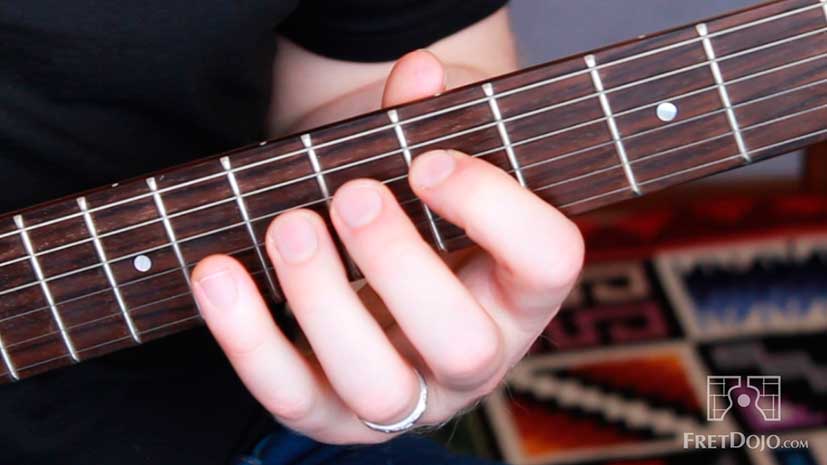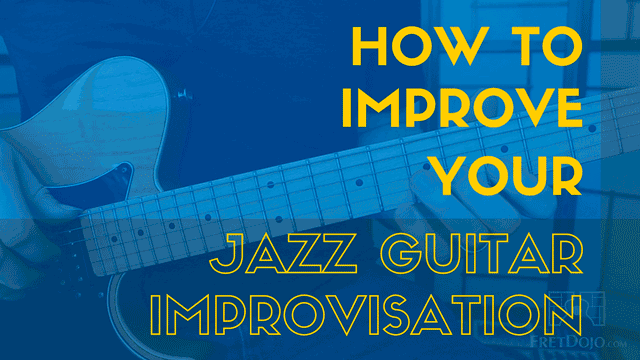
In this episode of the FretDojo.com Podcast, lets dive deep into a topic that’s critical in your development as a jazz guitarist:
The importance of jazz vocabulary – and how to go about learning it!
Check out the podcast here:
Podcast: Play in new window | Download (Duration: 22:49 — 20.9MB)
Get Notified Of Future Episodes Apple Podcasts | TuneIn | RSS | More
What made Joe Pass such an incredible jazz guitarist?
Sure, he had great swing, a tasteful sense of how to shape a solo, and could play any hundreds of jazz standards at the drop of a hat.
But for me, there’s one thing that stands out in particular when it comes to Joe Pass.
It was his complete command – and sheer amount of – jazz vocabulary that he had at his disposal.
Which is the topic of today’s post, and why mastering vocabulary should be priority #1 when it comes to practicing jazz guitar.
Why Learning Vocabulary is So Important
Learning jazz without learning enough vocabulary is like learning a foreign language without learning many words.
The result:
You won’t be able to ‘speak’ jazz. Your musical conversation will be the equivalent of ‘Tarzan speak’.
Taking this analogy further – improvising is like having a conversation with the harmony of a jazz standard.
And if you don’t know to ‘say’ the right thing at the right time, you won’t leave a good impression!
To ‘converse’ with the harmony effectively, you need to not only know enough jazz ‘words’ and ‘sentences’ (more on this in a moment), but you also know how to use them in ways which clearly communicate your ideas.
Different Types of Jazz Vocabulary
The word ‘vocabulary’ is a pretty broad term when it comes to jazz. There are several types of vocabulary, such as:
- Pitch Vocabulary – such as melodic patterns and phrases
- Rhythm Vocabulary – different subdivisions of rhythms, rhythmic motives, familiarity with starting phrases on different points of the bar
- Articulation Vocabulary – I.e. the way you play the notes on the guitar, such as slides, accents, staccato, and vibrato
- Chordal Vocabulary – knowledge of different chord qualities and voicings.
I would also class substitutions as vocabulary as well, I.e. knowing how to apply melodic phrases in harmonic contexts different to the phrases original chord progression. But that’s another huge topic…
Anyway, a competent jazz improviser will have a large ‘stock’ of knowledge to draw from in all of these areas, that they then combine spontaneously in a solo.
If you feel like a ‘deer in the headlights’ when it’s time to take a solo, it’s likely you don’t have a large enough ‘stock’ of vocabulary – OR perhaps you do have enough vocabulary but are not familiar with it enough for it to be useful for spontaneous improvisation, as I’ll detail below…
Common Mistakes When Learning Jazz Vocabulary
Mistake #1 – Skimming rather than Diving Deep
Here’s the thing:
You don’t need to learn a lot of jazz vocabulary to be a competent jazz guitarist.
It’s far better to dive deep on just a few elements that really appeal to you.
One teacher told me once that ‘Just keep learning loads of transcriptions and vocabulary, and then see what sticks to your playing’.
But, I now don’t agree with this – it’s not an efficient learning approach, to ‘throw a heap of stuff at the wall and see what sticks’.
You are much better of selecting a piece of vocabulary that you like, and then really working on incorporating it deeply in your playing, so it firmly becomes part of your language.
Mistake #2 – Attempting to increase vocabulary just by learning full transcriptions of solos
Although learning to play a full transcription of another jazz musicians solo is an excellent way to teach you about many aspects of jazz such as overall feel, appreciation of how to structure a solo etc, it won’t directly teach you vocabulary that you can spontaneously incorporate into your own solos, in and of itself.
You need to go further than this with a transcription if the aim is to increase your vocabulary, by taking the time to deliberately extract the most appealing vocabulary the soloist uses, and then work it into your own solos deeply.
See below for some practice methods which I use to get the most out of the ideas I come across in transcriptions.
Practice Ideas For Learning Vocabulary
Let’s take an idea such as a ii – V – I line I’ve studied from a Joe Pass recording. How would I go about studying this line so that it would stick into my playing?
Here’s some of the key ways I go about this:
- Learn the line in at least a few fretboard areas (e.g. if you know the CAGED system, see if the line fits in at least 2 other positions of that system)
- Ensure you can play the line from memory as soon as possible, rather than rely on the sheet music – otherwise you might have the illusion that you know the line better then you actually do.
- Move the line up the fretboard one fret at a time: Play the line in the original position and key. Then, simply move it up one fret and try to play it again, and work your way up and down the fretboard at least a few frets. Yes, it sounds simple – but can be quite challenging initially!
- Play the line around the circle of 4ths (I.e. the ‘reverse’ direction of the circle of 5ths) – make a backing track that has ii – V – I progressions in the circle of 4ths and attempt to nail the line in every key change. Why the circle of 4ths? It resolves more naturally to each key in the circle.
- Play the line with a different rhythmic pattern: E.g. if it is in eighth notes, attempt to play it in triplets, or sixteenth notes.
- Play along with a backing track of a jazz standard you are familiar with, e.g. ‘All The Things You Are’, and attempt to play the line (or parts of the line) as many places as possible throughout the progression.
- Investigate the nuts and bolts of what elements comprise the line. Extract concepts you find and make them a soloing focus on a jazz standard of your choice. As an exercise, I like to extract key concepts from lines I like the sound of then compose my own original lines based on those ideas.
These ideas are particularly appropriate when studying licks. Have a think about ways you could practice rhythmic vocabulary, articulation vocabulary, etc – so the ideas firmly ‘stick’ in your solos.
Summary
Overall, the approach that I’ve found works well to broadening my jazz vocabulary is to isolate a particular idea (whether it’s pitch ideas, rhythm ideas, articulations or whatever), and make it the sole focus of my practice over a few days, using the varied practice approaches listed above. Focus is the key.
To sum up:
- Learning to improvise in a jazz style is primarily concerned with acquiring a large stock of vocabulary, and then deliberately practicing that vocabulary to attain ‘agility’ and spontaneity so that you could potentially apply the vocabulary in any solo.
- Select ideas from recordings, courses or transcriptions that you enjoy the sound of – aim for a select amount of ideas that appeal to you rather than thinking you need to learn every Charlie Parker line to be able to play jazz!
- Deliberately practice these ideas with laser-like focus using ideas along the lines of what was covered in this article, until the vocabulary becomes a natural part of your playing
- Go further and extract key concepts from vocabulary you learn, and use that as the building blocks for developing your own vocabulary and hence your own unique sound as a jazz musician.
Tip: My FretDojo Jazz Guitar Academy teaches vocabulary according to this process, where every month you get to study new hand-picked vocabulary from master players and then apply them over classic jazz standards. For more info about working with me in the Academy, click here>>
I hope you enjoyed reading my musings about learning jazz vocabulary today. How about you? Do YOU have ideas or comments on this topic? Leave a comment below and let’s get the conversation started…


Really good advice. Thanks.